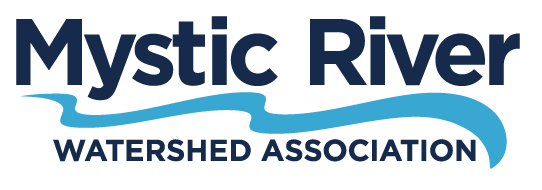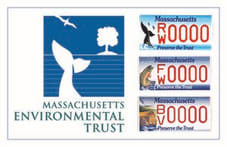TREE TRENCHES
A nature-based cooling solution that uses stormwater to expand and strengthen our urban canopy
MyRWA, in collaboration with the cities of Everett, Chelsea, and Melrose, is working on a project to increase the number of street trees and reduce flooding by designing and installing tree trenches in these cities. Both Everett and Chelsea’s climate resilience plans identify “Plant[ing] trees in places with high levels of heat (Urban Heat Islands)” as a priority. Melrose’s plan prioritizes green infrastructure to mitigate flooding risk from extreme precipitation. This two-year project, funded through the state Municipal Vulnerability Preparedness (MVP) program, continues regional efforts to decrease dangerous urban heat islands and reduce flooding in vulnerable neighborhoods.
Conceptual design of a tree trench with surface-level runoff watering. Credit: Horsley Witten
How do tree trenches work?
Tree trenches work by directing water from impervious surfaces in the surrounding blocks toward a tree. On the surface, the tree trench will look like a street tree pit. But, below the tree, there will be a storage and infiltration space which will store runoff, water the tree, and recharge groundwater. In addition to decreasing tree mortality, these tree trenches are likely to provide co-benefits like increasing tree canopy, cooling neighborhoods, providing habitat, improving water quality, improving air quality, and increasing tree survivability.
PROJECT GOALS:
This project has two phases:
Year 1:
Design of a low-cost tree-basin/trench based on previous tree models applied in other cities
Public engagement to prioritize locations and optimize the design
Desktop analysis and field visits to identify locations optimized for cooling vulnerable populations, while maximizing co-benefits
Year 2:
Installation of 25 trenches across Everett, Melrose, and Chelsea
Outreach projects across the Mystic River watershed to share results and lessons learned from the project
Community SURVEY
We are gathering community input about the existing tree canopy in your neighborhood, where trees are needed, and how important the co-benefits of tree trenches are to your community. You can fill out a short survey to get your voice heard below. You can see preliminary survey results (through June 2024) here.
Design and installation (For engineers)
Tree Trenches allow communities to integrate green stormwater infrastructure (GSI) with efforts to mitigate climate pressures that create health risks, social vulnerabilities, and public and private infrastructure impacts, particularly to environmental justice residents. Trees are critical elements of nature-based solutions because of the numerous benefits they provide:
Uptake of stormwater through interception, soil, storage, and evapotranspiration;
Uptake and filtering of stormwater pollutants;
Increased Infiltration into the groundwater table through extensive root systems;
Improved air quality;
Increased shade and reduced urban heat island effect;
Improved wildlife habitat and biodiversity; and
Improved aesthetics.
In contrast to the many benefits of trees in urban environments, trees can also face many challenges that can affect their success. Trees need adequate space and soil quality for their developing root systems. Steep-sloped areas and low-lying flood-prone areas can be difficult for soil and root systems to overhead and underground utilities, buildings, and paved areas (e.g., driveway, sidewalk, parking lots) all provide constraints.
Tree trenches and tree pits incorporate a street tree with a storage volume in stone void space below that allows for detention, infiltration and recharge of water into surrounding groundwater. These systems may be drained to capture flow from a catch basin, from overland flow through a curb inlet or from surface inlets. Excess stormwater is directed back to the right-of-way or to the existing stormwater system.
Engineering detail of a tree trench.
Interested in building tree trenches in your community, click the button to access more documents.
Project Team
Marja Copeland, Mystic River Watershed Association (marja.copeland@mysticriver.org)
Isaiah Johnson, Mystic River Watershed Association (isaiah.johnson@mysticriver.org)
Andy Hrycyna (andrew.hrycyna@mysticriver.org)
Natalia Bayona (natalia.bayona@mysticriver.org)
Tom Philbin, City of Everett
Jay Coy, City of Melrose
Kristen Homeyer, City of Chelsea
Jennifer Relstab, Horsley Witten






